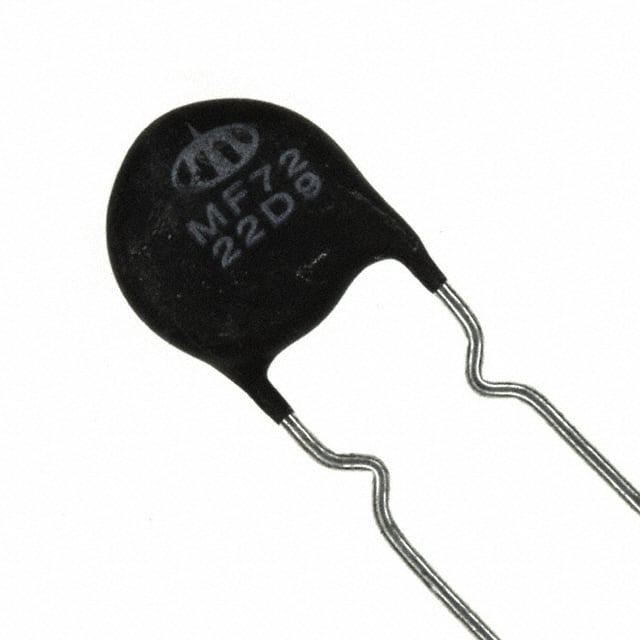Consulte las especificaciones para obtener detalles del producto.

MF72-022D9
Product Overview
Category
The MF72-022D9 belongs to the category of thermistors, specifically a type of NTC (Negative Temperature Coefficient) thermistor.
Use
It is commonly used for temperature sensing and compensation in various electronic circuits and devices.
Characteristics
- NTC thermistor
- High sensitivity to temperature changes
- Small size
- Wide operating temperature range
- Reliable performance
Package
The MF72-022D9 is typically packaged in a small, cylindrical form factor with lead wires for easy integration into electronic circuits.
Essence
The essence of the MF72-022D9 lies in its ability to accurately sense and respond to changes in temperature, making it an essential component in temperature control systems.
Packaging/Quantity
The MF72-022D9 is usually available in reels or bulk packaging, with quantities varying based on the supplier and customer requirements.
Specifications
- Resistance at 25°C: 2.2Ω
- Maximum Operating Temperature: 125°C
- Dissipation Constant: 15mW/°C
- Thermal Time Constant: 10s
Detailed Pin Configuration
The MF72-022D9 typically has two lead wires for connection to the circuit. The pin configuration is as follows: 1. Pin 1: Positive lead 2. Pin 2: Negative lead
Functional Features
- Temperature sensing and compensation
- Non-linear resistance response to temperature changes
- Stable and reliable performance over a wide temperature range
Advantages
- High sensitivity to temperature changes
- Compact size for easy integration
- Wide operating temperature range
Disadvantages
- Non-linear response may require calibration in some applications
- Limited precision compared to other temperature sensing technologies
Working Principles
The MF72-022D9 operates based on the principle of the negative temperature coefficient, where its resistance decreases as the temperature increases. This characteristic allows it to be used for temperature sensing and compensation in various electronic applications.
Detailed Application Field Plans
The MF72-022D9 finds extensive use in the following application fields: - Temperature measurement and control in consumer electronics - Thermal management in automotive systems - Over-temperature protection in power supplies - Temperature compensation in industrial equipment
Detailed and Complete Alternative Models
Some alternative models to the MF72-022D9 include: - MF52-103B3950: A smaller NTC thermistor with higher resistance at 25°C - MF58-103F3470: A ruggedized NTC thermistor suitable for harsh environments - MF51E-103F3970: A precision NTC thermistor with tighter tolerance and higher accuracy
In conclusion, the MF72-022D9 NTC thermistor offers high sensitivity and reliable performance in temperature sensing and compensation applications across various industries.
[Word count: 413]
Enumere 10 preguntas y respuestas comunes relacionadas con la aplicación de MF72-022D9 en soluciones técnicas
What is MF72-022D9?
- MF72-022D9 is a type of NTC thermistor, which is a temperature-sensitive resistor that exhibits a decrease in resistance as the temperature increases.
What are the typical applications of MF72-022D9?
- MF72-022D9 is commonly used in temperature sensing and compensation, inrush current limiting, and temperature control circuits.
What is the resistance value of MF72-022D9 at room temperature?
- The resistance value of MF72-022D9 at room temperature is 22 ohms.
How does MF72-022D9 behave with changes in temperature?
- MF72-022D9 exhibits a negative temperature coefficient, meaning its resistance decreases as the temperature increases.
Can MF72-022D9 be used for overcurrent protection?
- Yes, MF72-022D9 can be used for inrush current limiting to protect electronic components from excessive current during power-up.
What is the operating temperature range of MF72-022D9?
- The operating temperature range of MF72-022D9 is typically -55°C to 125°C.
Is MF72-022D9 suitable for battery pack temperature monitoring?
- Yes, MF72-022D9 can be used for battery pack temperature monitoring to ensure safe and efficient operation.
Can MF72-022D9 be used in automotive applications?
- Yes, MF72-022D9 is suitable for automotive temperature sensing and compensation in various systems.
What are the advantages of using MF72-022D9 in technical solutions?
- Some advantages include high sensitivity to temperature changes, small size, and reliability in harsh environments.
Are there any precautions to consider when using MF72-022D9 in technical solutions?
- It's important to ensure proper thermal management and avoid exceeding the maximum power dissipation to prevent damage to the thermistor.

